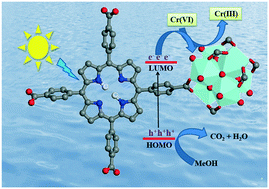Highly efficient visible-light-driven reduction of Cr(vi) from water by porphyrin-based metal–organic frameworks: effect of band gap engineering on the photocatalytic activity†
Abstract
Highly efficient visible-light-assisted photocatalytic reduction of Cr(VI) to Cr(III) from water using multifunctional Zr(IV)-porphyrin MOFs, Zr6(μ3-OH)8(OH)8(MTCPP)2, (PCN-222(M)) (M = H2, ZnII, CuII, NiII, CoII, FeIIICl, and MnIIICl) is presented. The remarkable chemical stability of these Zr-MOFs in water and the visible-light harvesting property of the porphyrin-linker promoted efficient photocatalytic activity for the reduction of Cr(VI) to Cr(III) in the aqueous phase. Interestingly, the pristine MOF, PCN-222, showed an unprecedentedly high photocatalytic activity with 100% reduction of Cr(VI) to Cr(III) within 25 min with the highest rate (0.1289 min−1) amongst the MOFs reported so far. The superior photocatalytic activity of PCN-222 (no metal) over PCN-222(M) MOFs has been attributed to its lower band gap and efficient transfer of photo-excited electrons to the catalytic site, supported by combined experimental and theoretical studies. Remarkably, the PCN-222 MOF catalyst could be reused for up to 10 cycles without significant loss of catalytic activity. Further, a detailed mechanistic investigation of the visible light-assisted photoreduction of Cr(VI) by combined experimental and theoretical studies is presented. Overall, this work represents a unique demonstration of the influence of band gap engineering of porphyrin MOFs for efficient aqueous-phase photoreduction of Cr(VI) from water under visible light irradiation.



 Please wait while we load your content...
Please wait while we load your content...